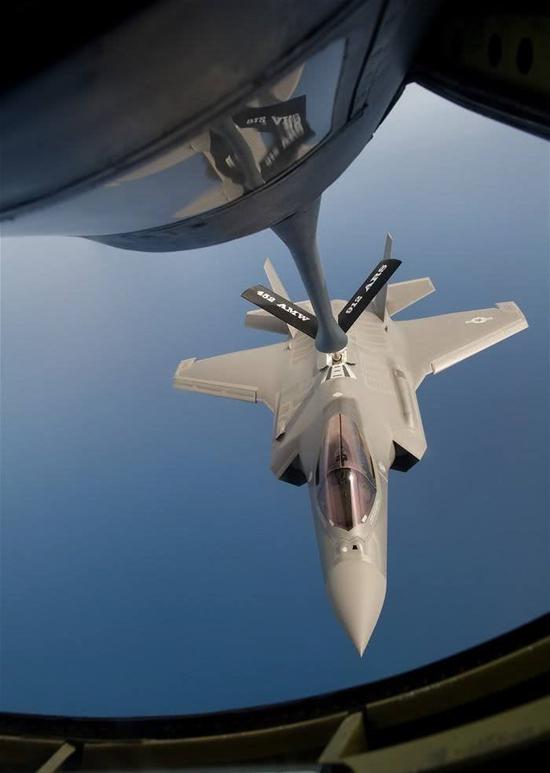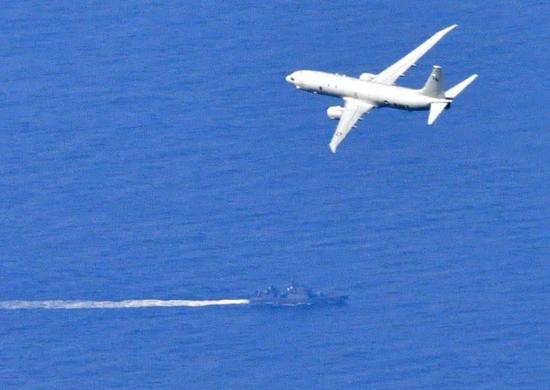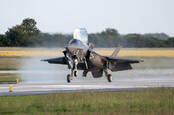The American idiots used to brag how powerful is F-35 being a CYBER HUB in the air, and yes, that is why enemies can all HACK THE FUCK OF THEM, and more serious and deadly than WIKILEAK HACKS, it will disable attacks, make wrongful attack, or just simply shut off pilots' Oxygen supply. And that was the likely reason why Japanese F-35 crashed and pilot dead. No oxygen he past out and jet crashed soon!
Easy to kill! No missiles needed! No evidence who did it! Can hack F-35 trick it to attack own friends of civilian jets! No evidence who did it too!
https://mil.news.sina.com.cn/jssd/2019-04-26/doc-ihvhiewr8396974.shtml
美军警告日本:F35或遭黑客攻击 飞行员驾机会昏迷
2019年04月26日 16:31 新浪军事
0

日本首架坠毁的F-35A隐身战斗机和机上飞行员至今仍未找到,但由美国方面主导的事故调查却取得重大进展。日本经济新闻社4月25日披露,美国军方向日本防卫省发出紧急警告,称F-35战机可能受到了黑客攻击。目前美方已将战机坠毁的原因归结为“突发性系统故障”,其中机载氧气生成系统出问题的可能性最大。也就是说,至今仍失联的41岁空自少校飞行员在驾机时可能因缺氧而昏迷,F-35A战机在失去人工控制后坠毁。
日经社报道称,日本政府刚于23日派出一艘最先进的深海救援特种船只加入搜索,紧接着就收到了来自美国军方的通报,称正在集中调查F-35战斗机的机载供氧系统,并认为该系统突发故障中断供氧是导致日本F-35A坠毁的原因。飞行员在驾驶战斗机时全靠机载设备提供氧气,如果座舱供氧停止的话,会在不知不觉中因缺氧而失去意识,从而导致飞机失事。此前,美军另一款五代隐身机F-22已经发生过类似事故,自己装备的F-35也出现过供氧系统故障问题。

美军方在通报中特别强调,现已查明F-22、F-35战斗机在进行“系统更新升级”时最容易遭到黑客攻击。黑客会通过网络入侵等手段篡改机载软件数据,或埋下会在未来某个时候发作的病毒。对于通过机载中央处理器控制一切系统的五代机来说,一旦在飞行中有软件出现重大错误,基本等于让飞机陷入失控状态。日本媒体获得的通报内容未提及美军方是否确认了黑客来自哪个(或哪些)国家或地区。
《读卖新闻》援引日本政府消息人士的话报道称,此前有新闻称美国为了与日本联合研制用于取代F-35的第六代战机,打破常规向日方提供了设计F-35战机时的绝密源代码,这一报道并不完全属实。该消息人士表示,美国向日本提供的是F-35战机发动机系统和武器系统的控制软件代码,为的是加强战机机载处理系统的“防火墙”,阻止黑客成功入侵。

在日本首架国内组装生产的F-35A战机失事坠毁后,美日媒体的关注点很快被“带偏”,因为美国空军前高级将领和不少军事专家纷纷表示,俄罗斯等周边大国对争夺战机残骸有非常浓厚的兴趣。还有美国媒体甚至报道称,战机失事海域附近已经出现不明国籍潜艇踪迹。类似的报道直到美国五角大楼早前正式做出澄清,称没有任何迹象表明有其他国家的舰船或飞机出现在相关海空,才告一段落。
现在日本媒体又曝出美国军方称有黑客攻击F-35战机系统,预计接下来美日媒体的报道焦点还会在失联的空自飞行员以外。俄媒体援引专家的话报道称,F-35确实代表了当今世界战斗机的最高水平,却也并非“唯一”。而且就算俄罗斯等国想了解其技术原理,也不可能在美日军舰和飞机几乎24小时巡逻的情况下有何作为。因为一旦被美日舰机发现,有可能会发生擦枪走火的危险事件。

实际上,在茫茫大海上搜索一架比民航客机小得多的战斗机残骸,就算美国和日本都是世界顶尖的科技强国,也不能轻松办到。相反,已经沉入约1500米深海底的F-35机体或零部件,有可能因洋流影响而不断漂动,最终出现在让人意想不到的海岸。(作者署名:百战刀)
US military warned Japan: F35 or hacked pilots drive to coma
April 26, 2019 16:31 Sina Military
0
Japan’s first crashed F-35A stealth fighter and in-flight pilots have yet to be found, but the US-led accident investigation has made significant progress. The Japan Economic News Agency disclosed on April 25 that the US military issued an emergency warning to the Japanese Defense Ministry, saying that the F-35 fighter might have been hacked. At present, the United States has attributed the crash of the aircraft to "bursty system failure", in which the possibility of airborne oxygen generation system is the most likely. In other words, the 41-year-old airborne major pilot who still lost the link may be unconscious due to lack of oxygen while driving. The F-35A crashed after losing manual control.
The Nikkei reported that the Japanese government had just sent a state-of-the-art deep-sea rescue special vessel to the search on the 23rd, and then received a notification from the US military that it was investigating the on-board oxygen supply of the F-35 fighter. The system, and believe that the sudden failure of the system to interrupt oxygen supply is the cause of the crash of the Japanese F-35A. When pilots are driving fighters, they rely on airborne equipment to supply oxygen. If the cabin's oxygen supply is stopped, it will unconsciously lose consciousness due to lack of oxygen, which will cause the plane to crash. Previously, another five-generation stealth machine F-22 of the US military had a similar accident, and the F-35 equipped with its own had problems with the oxygen supply system.
In the briefing, the US military specifically emphasized that the F-22 and F-35 fighters have been found to be the most vulnerable to hackers when conducting "system upgrades." Hackers will tamper with on-board software data through network intrusions or other means, or bury viruses that will occur sometime in the future. For the fifth-generation machine that controls all systems through the onboard central processor, once there is a major error in the software in flight, it is basically equal to let the aircraft fall into a state of control. The notifications obtained by the Japanese media did not mention whether the US military confirmed which country (or countries) the hackers came from.
"Yomiuri Shimbun" quoted Japanese government sources as saying that there was news that the United States had jointly developed a sixth-generation fighter to replace the F-35 with Japan, and broke the routine to provide the Japanese with the design of the F-35. Top secret source code, this report is not entirely true. The source said that the United States provided Japan with the control software code for the F-35 fighter engine system and weapon system, in order to strengthen the "firewall" of the aircraft airborne processing system to prevent hackers from successfully invading.
After the crash of the first F-35A fighter aircraft assembled and produced in Japan, the focus of the US and Japanese media was quickly "biased" because the former senior generals of the US Air Force and many military experts said that Russia and other neighboring countries competed. The wreckage of the fighters has a very strong interest. There is also a report from the US media that there have been unidentified nationality submarine trails near the sea of warplanes. A similar report until the US Pentagon officially made a clarification earlier, saying that there is no indication that ships or aircraft from other countries have appeared in the relevant air and sea.
Now the Japanese media has revealed that the US military has said that there are hackers attacking the F-35 fighter system. It is expected that the focus of the US and Japanese media coverage will be outside the lost pilots. The Russian media quoted experts as saying that the F-35 does represent the highest level of fighters in the world today, but it is not "only." And even if Russia and other countries want to understand its technical principles, it is impossible to do anything in the case of US and Japanese warships and aircraft patrolling almost 24 hours. Because once it is discovered by the US-Japan ship, there may be a dangerous incident of firearms.
In fact, searching for a wreck of a fighter plane much smaller than a passenger airliner on the vast sea, even if the United States and Japan are the world's top technology powers, can't easily do it. On the contrary, the F-35 body or parts that have sunk into the depths of about 1,500 meters may be drifting due to the influence of ocean currents, and eventually appear on the unexpected coast. (Author's signature: Bai War Knife)
https://asia.nikkei.com/Spotlight/C...ws-problems-still-lurk-behind-stealth-fighter
F-35 crash shows problems still lurk behind stealth fighter
Oxygen supply system raises questions as search for pilot and plane continues
TETSURO KOSAKA, Nikkei senior staff writer April 23, 2019 12:16 JST

An F-35A fighter jet at the Paris Air Show. U.S. pilots of F-35s and other planes have reported symptoms that suggest an oxygen shortage. © Reuters
TOKYO -- In the weeks since a Japanese F-35A stealth fighter jet crashed into the Pacific Ocean, the U.S. and Japan have not yet found either the plane or the cause of the incident. But it could be linked to a system that has bedeviled the American military for years.
All F-35s have onboard oxygen generation systems, or OBOGS, which draw oxygen from the surrounding air and supply it to the pilot at the high concentration necessary to operate at high altitudes. The U.S. Air Force, Navy and Marine Corps have used OBOGS for more than three decades, in models including the F-16 and F/A-18 as well as certain training planes.
But since the U.S. began using OBOGS in the F-22 in 2008, there have been more than 20 cases of F-22 pilots experiencing symptoms indicating a lack of oxygen, apparently due to problems with the system. An F-22A crashed in November 2010 in an incident that may have resulted from an oxygen shortage.
Low levels of oxygen in the bloodstream -- known as hypoxia -- can cause sweating, headaches and dizziness, followed by vision problems and trouble making decisions, and eventually loss of consciousness. After the 2010 crash, the U.S. military temporarily stopped using OBOGS in the F-22 while it worked to address the issue, in part by replacing components in the system.
But the problem persisted in multiple jet models, including the F-35A. The military has not worked out the cause but reportedly has increased the emergency oxygen supply provided to pilots in case the OBOGS fails, among other precautions. Put bluntly, it is employing every trick it can think of to keep using the system.
With the Japan incident, the Air Self-Defense Force pilot called a halt to his training exercise just before the crash. This suggests that he realized something was wrong, after which the situation quickly deteriorated. That would fit with hypoxia caused by an OBOGS malfunction.
Such problems are a risk in the modern era. These days, all aircraft, civilian or military, are filled with electronics requiring complex software to run. As such, new planes must be put through a series of test flights to find and correct any problems in the code.
Test pilots, as well as the first pilots to operate new models after their rollout, must fly without knowing whether bugs might still lurk in their planes' programming. The task is a dangerous one.
The ASDF grounded all of its F-35As after the crash. At this point, it is impossible to tell whether the OBOGS might have been involved in the incident. But whether or not this turns out to be the case, given the long-running issues with the system in the U.S., Japan must also consider it suspicious.
But the ASDF cannot simply modify the planes to remove the OBOGS and use liquid-oxygen systems like those in the F-15, its current mainstay, because that would break the terms of its deal with Washington. This is a major downside to buying foreign jets.
There is one other concern. In June 2017, the USS Fitzgerald, an American destroyer equipped with the Aegis missile defense system, collided with a Philippine containership off the Japanese coast, killing seven people on board. The captain and another officer were court-martialed for criminal negligence. But the U.S. Navy recently made the unusual decision to withdraw the charges.
Like modern fighter jets, Aegis-equipped vessels are full of electronics. The accident prompted speculation that the Fitzgerald could have been hacked or hit with an electromagnetic pulse attack that caused systems to malfunction.
With military secrets involved, the truth remains a mystery. But the strange decision to withdraw charges over an incident that caused multiple deaths raises the possibility that hacking was found to have been involved, leading the military to conclude that the officers were blamed in error.
There are worries that the F-35A and the F-22 could be hacked -- perhaps during system updates -- to plant the seeds for future software problems. The U.S. military is believed to be looking into this risk with respect to the OBOGS malfunctions.
A national security source said of a recent piece on the American scramble to keep the F-35's secrets safe from Russia and China: "I agree with it, but the situation is more serious than that," the source said. What that could mean remains a mystery of its own.
https://sputniknews.com/asia/201904251074451333-japan-missing-f-35-fighter-jet/
Listen Live
Search

Fears of F-35 Software Hack as Search Underway for Missing Japanese Warplane
CC BY-SA 2.0 / Airwolfhound / F22 Raptor & F35 Lightning II
Asia & Pacific
14:49 25.04.2019(updated 14:53 25.04.2019) Get short URL
10372
On Tuesday, Tokyo reportedly announced the deployment of a special state-of-the-art vessel as part of the ongoing around-the-clock search for the Japanese Air Self-Defence Force’s missing F-35A fighter jet, which disappeared from radars during drills over the Pacific Ocean on 9 April.
With a missing Japanese F-35A fighter yet to be tracked down, the US military has suggested that the software of this fifth-generation warplane could be hacked, Nikkei reports.
According to the Japanese media outlet, the US military “is believed to be looking into this risk with respect to the OBOGS (on-board oxygen generation systems) malfunctions” which are thought to be behind the crash of the Japanese Air Self-Defence Force (JASDF)’s F-35A jet.
READ MORE: Japanese Military Found F-35 Debris, Pilot Still Missing — Reports
“There are worries that the F-35A and the F-22 (fighter jet) can be hacked — perhaps during system updates — to plant the seeds for future software problems," Nikkei noted.
This comes after the newspaper Yomiuri Shimbun cited unnamed Japanese government sources as saying that the US proposed handing the secret codes to the software installed in the F-35 air-frame to control parts, including the engine and the missiles, to Japan.
Earlier, Japanese Defence Minister Takeshi Iwaya told the Japan Times that “the F-35A is an airplane that contains a significant amount of secrets that need to be protected”.
The newspaper also quoted an unnamed Japanese Defence Ministry spokesman as saying that the remains of the missing jet’s tail had been found but that they had yet to track down the rest of the fuselage, as well as the remains of the pilot.
READ MORE: Japan to Continue Buying American F-35 Jets Despite Recent Plane Crash — MoD
Takeshi, for his part, had previously announced that Tokyo would ground the JASDF's whole fleet of F-35A fighters in connection with the crash, but he then made an about-face by announcing that Japan has not changed its F-35 acquisition plan.
In the latest development, the Japan Agency for Marine-Earth Science and Technology research vessel Kaimei reportedly joined the search for the missing jet.
The ship is equipped with echo-sounders and magnetometers, and also carries an unmanned submersible capable of reaching depths of up to 3,000 metres.
READ MORE: Japan Searches for Crashed F-35 Jet Underwater to Recover Debris ASAP

CC BY-SA 2.0 / aceebee / Boeing P-8A Poseidon
US Navy P-8A, Destroyer Join Japan Military in Search for F-35A Pilot
The JASDF’s F-35A Lightning II Joint Strike Fighter, while being flown by 41-year-old Major Akinori Hosomi, reportedly disappeared from radars on 9 April, 135 kilometres (84 miles) east of Misawa Air Base, located in the country's northern Aomori prefecture.
The incident took place during a training flight involving four F-35A fighters; it is the first case of an F-35A crashing, as the warplane, introduced in 2016, has only recently come into service in various countries.
...
https://www.theregister.co.uk/2019/03/28/f35_software_fail/
Easy-to-hack combat systems, years-old flaws and a massive bill – yup, that's America's F-35
POGO says no-go on money-pit jet fighter
By Shaun Nichols in San Francisco 28 Mar 2019 at 23:37
84

The F-35 aircraft remains woefully unprepared against malware infections and other cyber-attacks, according to POGO – the respected non-profit watchdog Project on Government Oversight.
Dubbed the most expensive weapon system in history, the beleaguered fighter jet is plagued with problems, including a lack of protection against software nasties that would cripple its critical systems, it is claimed. Cybersecurity protections are particularly important because the aircraft relies so heavily on a network of automated systems to operate properly, we're told.
"The fully integrated nature of all F-35 systems makes cybersecurity more essential than for any other aircraft," POGO's Dan Grazier noted this month, having obtained documentation that the jet has low "fully mission capable" rates. That's military jargon meaning it's rarely fully ready for combat.
"Legacy aircraft already in service are equipped with software-enabled subsystems, and while a hacker could penetrate the GPS system in a legacy system, because the subsystems are not fully integrated, a hacker could not also access the communications system, for example," Grazier continued. "The F-35 is inherently far more vulnerable."
 F-35 'incomparable' to Harrier jump jet, top test pilot tells El Reg
F-35 'incomparable' to Harrier jump jet, top test pilot tells El RegREAD MORE
Most worryingly, a report in October from the US government's General Accountability Office found the Department of Defense had failed to protect the software used to control the F-35's weapons systems. Testers could take control of weapons with "relatively simple tools and techniques."
To give you an idea of how the interconnected nature of the F-35's computer systems is a massive vulnerability in of itself: separate subsystems, such as the Active Electronically Scanned Array radar, Distributed Aperture System, and the Communications, Navigation, and Identification Avionics System, all share data. Thus, the GAO's auditors warned, just compromising one of these components could bring down the others.
“A successful attack on one of the systems the weapon depends on can potentially limit the weapon’s effectiveness, prevent it from achieving its mission, or even cause physical damage and loss of life,” said the GAO team.
ALIS in crazyland
POGO's Grazier also noted the Autonomic Logistics Information System (ALIS) – a network of on-board gear, and ground-based web-browser-accessed systems, that serve as the primary remote diagnostics and management tools for the planes – continues to harbor a number of security vulnerabilities that have been known of for years, and not yet resolved.
Should one of those ALIS flaws be exploited by miscreants, Grazier warned, the tech-heavy F-35s could end up crippled by deliberately falsified instrument readings as a result of that exploitation, or grounded for bogus repairs – ALIS is used to schedule maintenance and order spare parts. One flaw, identified in 2012, would incorrectly report aircraft as unfit for service, and has yet to be fixed over six years later.
"As in previous years, cybersecurity testing shows that many previously confirmed F-35 vulnerabilities have not been fixed, meaning that enemy hackers could potentially shut down the ALIS network, steal secret data from the network and onboard computers, and perhaps prevent the F-35 from flying or from accomplishing its missions," Grazier wrote.
As for penetration testing of the ALIS system, Uncle Sam dropped the ball, the independent watchdog suggested. Rather than unleash a DoD red team of hackers on the code, the US government paid F-35 manufacturer Lockheed Martin to do it, and just accepted the results. Such hands-off regulation didn't work out so great for Boeing and America's aviator regulator, the FAA.
ALIS, right now on software version 27, has other problems, too. The code is basically supposed to automatically detect any problems developing in the fighter jets well ahead of time, and arrange for repairs and spare parts so the planes can be fixed up before they have to be grounded for substantial work. Lockheed designed it this way to save time and money, with constantly updated databases of spare parts, logistics plans, and aircraft testing records – yet a report from the Pentagon last year said inputting information about repairs into ALIS often took longer than the repairs themselves.
 Britain's new F-35s arrive in UK as US.gov auditor sounds reliability warning klaxon
Britain's new F-35s arrive in UK as US.gov auditor sounds reliability warning klaxonREAD MORE
POGO's findings are the latest bit of bad news for an F-35 program that has fallen hopelessly behind schedule thanks to a parade of delays, glitches, and manufacturing nightmares that have driven what was once supposed to be a low-cost next-generation fighter into a $122m per unit expense. That's just the per-plane price tag: each one costs $30,000 an hour to fly, plus upgrade costs, and other expenditures.
In addition to the US, UK, and Australia, the militaries of Israel, Japan, Canada, and Italy have all been named as customers for the final toys.
This isn't the first time software problems have been reported in the F-35. Last year reports surfaced that the onboard code for a number of the various systems on the plane had become so incompatible with one another that they hampered the ability for manufacturers to perform flight tests. ®
Tips and corrections
